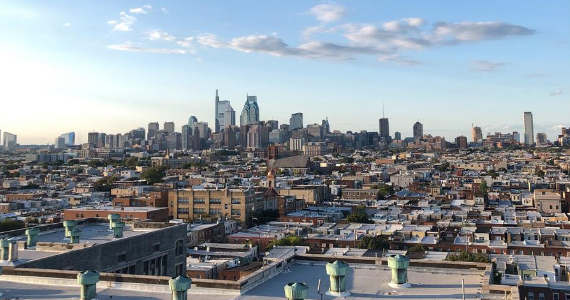A Pandemic Walk Through Philadelphia Neighborhoods
Posted on
August 31, 2020
 A view of Philadelphia, looking north toward Center City from the Bok Building.
A view of Philadelphia, looking north toward Center City from the Bok Building.
By Ana V. Diez Roux, MD, PhD, MPH
One of the unanticipated and surprising consequences of the pandemic is that I have gotten to know the streets of my city, Philadelphia, like never before. At the height of the pandemic, every evening my husband and I took long walks through the city. We wore masks and avoided other pedestrians as much as we could, crossing the street or stopping to let them pass by, a sad routine that has become a hallmark of our social interactions, something that none of us would ever have imagined that we would be doing just a few months ago.
Sometimes we walked straight south into South Philly, or north across Market and Fairmount and Girard, or west into West Philly past Clark Park. Other times we zigzagged, one block south, one block east, one south, one east and so on, until exhausted we found a bike and rode back. In all these walks we saw a city we thought we knew with new eyes, we saw old hidden gems of houses, churches and parks, new ugly modern condos, and the traditional Philadelphia rowhouses, some old and dilapidated, others newly painted with flowerpots in the windows. We saw the occasional neighbor sitting on the stoop, watching us sometimes a bit suspiciously, as we walked by.
For a large part of my public health research career I have studied how neighborhoods affect the health of the people who live in them. I have tried to make a case for why places, with all their intertwined social and physical attributes, are important to health. We have drawn countless maps of how neighborhoods vary dramatically in health and life expectancy. We have shown how access to healthy foods, levels of air pollution, and tree cover differ from neighborhood to neighborhood. Our team has done this for cities ranging from Chicago to Baltimore to Buenos Aires, and most recently of course for Philadelphia. And yet, as I walk through the neighborhoods around my home, I never fail to be amazed by how different neighborhoods can be in ways that are both blatant and subtle, and how obvious it is that they must affect the lives of residents in so many multifaceted ways.
Of course, these differences across neighborhoods are not natural. They emerge from a residential segregation closely linked to income inequality and racism that creates and reinforces dramatic differences in the social and physical features of the places where different social groups live. These differences are often linked to the history of neighborhoods as strikingly illustrated by a recent story in The New York Times aptly titled “The Climate Legacy of Racist Housing Policies” that showed the correlation between the redlining of majority Black neighborhoods in the 1930s and tree cover, paving and heat today, factors that create large differences across neighborhoods in vulnerability to the adverse health impacts of climate change. A history of disinvestment in these neighborhoods, poor neighborhoods or neighborhoods with majority Black residents, has led to dramatic differences today in the physical quality of these neighborhoods and in the local resources available to those who live there. Neighborhood differences therefore emerge as yet another manifestation of racism and structural inequalities.
The big question is what do we do today. How do we break the dynamic that links residential segregation by race and class to environments and opportunities? Clearly this cannot be addressed by investing in these neighborhoods in ways that displace current residents. And yet there must be ways to invest in these communities and improve neighborhood environments and resources in ways that are meaningful, transformative and directly benefit current residents. Some of these interventions may have to be place-based (some as simple as collecting trash, planting trees, improving the quality of streets and sidewalks, and recuperating abandoned or dilapidated buildings) but others will require acting on the systems of inequality and racism that drive residential segregation and that create links between segregation and adverse environments.
In some ways the pandemic has pulled us apart, forcing us to stay in our own homes and to avoid each other as we walk down the street. But in other ways the pandemic has allowed us to see things that have always been in plain sight much better than before, and perhaps envision a world in which these things could actually be different.
To learn more about the significant contrast in health outcomes for residents in the Philadelphia's 46 neighborhoods read "Close to Home: The Health of Philadelphia's Neighborhoods" (pdf), an August 2019 report developed by Dornsife researchers in partnership with the City of Philadelphia.